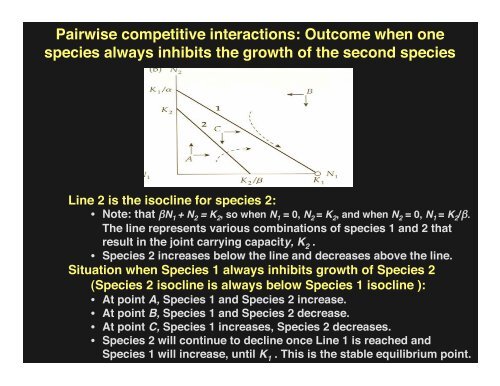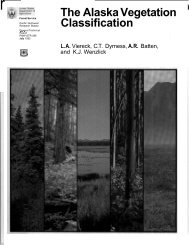Lectures on species interactions and competition
Lectures on species interactions and competition
Lectures on species interactions and competition
Create successful ePaper yourself
Turn your PDF publications into a flip-book with our unique Google optimized e-Paper software.
Pairwise competitive interacti<strong>on</strong>s: Outcome when <strong>on</strong>e<br />
<strong>species</strong> always inhibits the growth of the sec<strong>on</strong>d <strong>species</strong><br />
Line 2 is the isocline for <strong>species</strong> 2:<br />
• Note: that N 1 + N 2 =K 2 , so when N 1 = 0, N 2 = K 2 , <strong>and</strong> when N 2 = 0, N 1 = K 2 / .<br />
The line represents various combinati<strong>on</strong>s of <strong>species</strong> 1 <strong>and</strong> 2 that<br />
result in the joint carrying capacity, K 2<br />
.<br />
• Species 2 increases below the line <strong>and</strong> decreases above the line.<br />
Situati<strong>on</strong> when Species 1 always inhibits growth of Species 2<br />
(Species 2 isocline is always below Species 1 isocline ):<br />
• At point A, Species 1 <strong>and</strong> Species 2 increase.<br />
• At point B, Species 1 <strong>and</strong> Species 2 decrease.<br />
• At point C, Species 1 increases, Species 2 decreases.<br />
• Species 2 will c<strong>on</strong>tinue to decline <strong>on</strong>ce Line 1 is reached <strong>and</strong><br />
Species 1 will increase, until K 1<br />
. This is the stable equilibrium point.
















